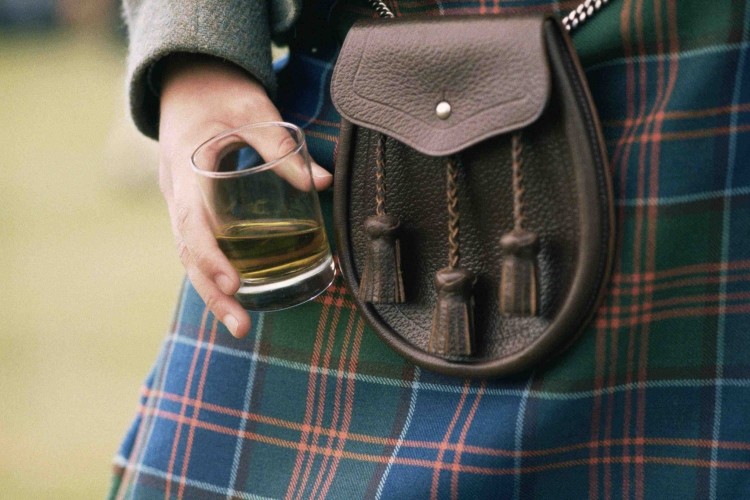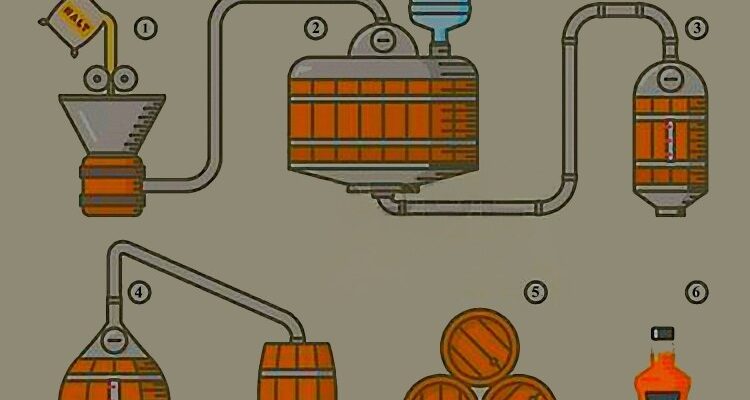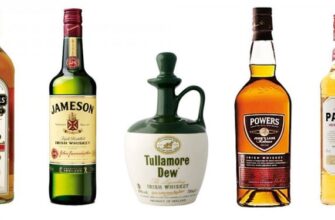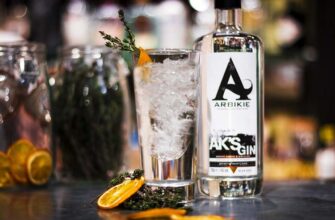Going to the store for a strong drink, you probably felt confused, standing in front of a huge display case with numerous brands of whiskey, bourbon or scotch. Trying to find on the Internet hints of what to buy, you find a description of the species: 'the drink has absorbed all the enchanting aroma of old oak or sherry barrels, with notes of smoke and vanilla flowing into a smooth aftertaste.' But that's all for experienced whiskey aficionados and true sommeliers. For an ordinary person, such a description is not enough. You must at least understand the basics. Today we'll talk about how to choose whiskey, how single malt whiskey differs from blended one, and finally how to drink it correctly. So, I promise it will be interesting. Forward!
Whiskey history
From ancient Greek technology and handicraft industries in Scotland to a global phenomenon, whiskey has come such a long way in its history.
Ancient technology
Distillation technology has been developed in many cultures, at different times, and has different goals. For example, about 2,500 years ago, Greek sailors boiled sea water to make it drinkable. About 2,100 years ago, after the same process, wine was already being produced and this was common.
In fact, the whole essence of distillation, mystical and chemical, has been intertwined over the centuries. But, it was the Persians and Arabs who shifted this process towards science.
Arrival in the UK
From the 12th to the 14th century, the distillation process moved from the East to Eastern Europe, and later to Western Europe. This was the period of the Renaissance, the awakening of a new Europe, based on the rediscovery of the knowledge of the ancient Greek world – an age of scientific discovery and invention. But this was also an age of great threats: the practice of distilling alcohol spread after the plague, which forced many to seek new solutions and medicines that would alleviate suffering and prevent death.
In August 1494, a certain monk John Core received an order from the king to make 2,400 bottles of aquavit, the water of life, from 1,120 kg of barley malt. This was the first written mention of whiskey.
 Despite the primitiveness of technology, the process of distilling whiskey itself was not very different from modern
Despite the primitiveness of technology, the process of distilling whiskey itself was not very different from modern
For the next two hundred years, nothing was known about the development of distillation and how aquavit or whiskey was used in Scotland.
Revival
This Scottish drink was revived only at the beginning of the 20th century. Despite its collapse towards the end of the 19th century, fierce competition from other whiskey producing countries, two world wars, the Great Depression and the American ban, Scotch whiskey survived to become the best in the world.
 A quick guide to the six most popular whiskeys around the world
A quick guide to the six most popular whiskeys around the world
How does single malt whiskey differ from blended?
Recently, whiskey has been quite popular with us. Some who have tried it at least once probably know that there is an expensive single malt whiskey and there is a more popular and affordable blended one. But what is the difference between them, many do not know exactly. Let's figure it out.
Well, we'll start with an expensive single malt or single malt whiskey. Roughly speaking, if you do not go into details, then this is whiskey, which is made from the main raw material for this drink, that is, from barley malt. The drink is aged for quite a long time, sometimes for 6, 10, 16 and even more years. The most important thing is that it matures for a long time and is not diluted in anything. Typically, single malt whiskey is produced in a single distillery. But it happens that several varieties of single malt whiskeys are blended.
Now let's move on to the blended or blended whiskey. This is an affordable whiskey and because of this is more popular, therefore it occupies 70-80% of the total whiskey market. The main idea behind its production is that expensive single malt whiskey is diluted with cheaper, less matured and, because of this, lower quality grain whiskey. Usually in blends the share of single malt whiskey is 15-20%, but there are also expensive whiskeys in which this percentage rises to 40-50, as for example in the popular Teacher's.
Blended whiskey, due to the fact that it is in great demand, is very common and has dozens of types. As for the price, at the moment a bottle of 0.7 blended whiskey starts at about 500 rubles for the same William lawson's or Bells. But these are the simplest types, and more or less good blends start at 800 rubles. Well, one malt starts at 2,000 rubles for 0.7.
 There is a very large selection of whiskey on store shelves, so picking something to your liking will not be difficult
There is a very large selection of whiskey on store shelves, so picking something to your liking will not be difficult
Now let's move on from theory to practice and see how single malt whiskey differs from blended one. At first you might think that if the whiskey is diluted, then, roughly speaking, it is not so tasty, it has not so much rich taste, color or bouquet of aromas as one malt. But in fact, everything very much depends on the variety, aging, in which barrels the drink is kept from which raw materials it is made, and so on.
For example, if we compare blended Ballantine’s and single malt McClelland’s Highland, we cannot say that the latter is richer in taste and greatly surpasses the opponent. Yes, these are drinks of different nature and it is not entirely correct to compare them. This is of course the case for this example. Well, in the blends, alcohols are more felt, well, and they are simpler in terms of taste and bouquet of aromas.
Hopefully, overall, you figured out how to choose a whiskey and what to look out for first.
How to drink whiskey
Good whiskey is a delicacy. They savor such a drink, admire it, inhale the aromas and enjoy the subtle notes in the bouquet. It is convenient to sip it in the evening while reading a book or watching a movie, and not throwing it mixed with cola, ice or anything else in a noisy company.
Therefore, taking into account all of the above, we can conclude that the vessel plays an important role here. The media, with their clips, TV shows, films and photographs, instilled in us a stereotype that whiskey is drunk from a glass of rocks and, moreover, with the addition of large cubes of people and pouring it all over with Coca Cola. I certainly do not discourage you, if you like the taste of whiskey with cola and ice, please drink, but you should not use an expensive drink for such a cocktail. Truth be told, there is so much sugar in cola that when mixed with a drink, it drowns out all the taste. So it's best to mix it with an inexpensive whiskey.
 A full set of stereotypes – whiskey is poured into a rock glass and covered with a bunch of ice
A full set of stereotypes – whiskey is poured into a rock glass and covered with a bunch of ice
Now let's talk about why you can't add ice to whiskey. This drink has a rich and bright aroma, its evaporation occurs at room temperature. Therefore, in order to enjoy a good whiskey, it does not need to be chilled, so do not store the bottle in the refrigerator, much less in the freezer. Ice will stop evaporation and thus kill half of the beauty, and besides, very soon it will begin to melt and let in a lot of water, after which the taste will deteriorate. And the smell and taste are the very main components of whiskey, for which it is so appreciated.
Every serious drink has its own glass shape, for example, brandy or wine glasses. Despite the fact that whiskey is most often associated with a rock glass, the most correct capacity is considered to be glencairn. And it's not just that this glass is considered the most suitable, because it is in it that you can concentrate the smell of the drink and how you should enjoy it.
When you have already figured out in what container to drink the water of life and with what, you can proceed to the very process of consumption. It is worth noting that whiskey, unlike vodka, is not drunk in one gulp. It would be more correct to sip a little. So one or two glasses will be enough for one evening.
At first, if you just want to get used to such a drink as whiskey and understand it, drink in small sips, a few drops are enough to cover the palate, tongue and feel the taste.
A few more words should be said about the food with which whiskey is combined. It just so happened that it is not accepted to seize this drink, since food clogs the taste buds and thereby spoils the whole ritual. But if you want to discover new facets and combinations of tastes while sipping an expensive smoky drink, then you should stick to the food that will not overpower the sensations with taste. Many people recommend oysters, mussels or jamon. Well, and most importantly, it should be something light – not super-sweet and not super-fat or salty. For example, nuts, dried fruits or apple slices will work well.
Conclusion
So, we touched on a very voluminous topic and got an idea of how to choose a whiskey for a gift or celebration. As you can see, there are a lot of subtleties in choosing this alcoholic beverage. If you follow some rules of whiskey consumption, then you will have a wonderful evening. And remember, if you can, then do not drink, but if you do, then only high-quality alcohol, although the Ministry of Health warns.









